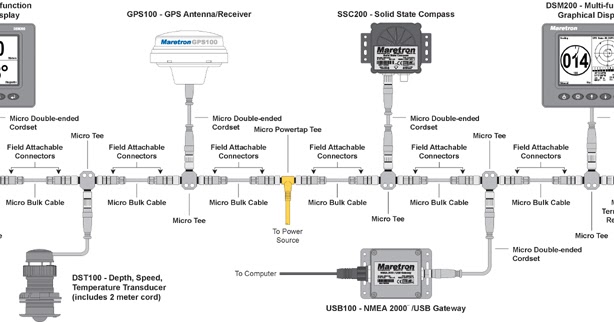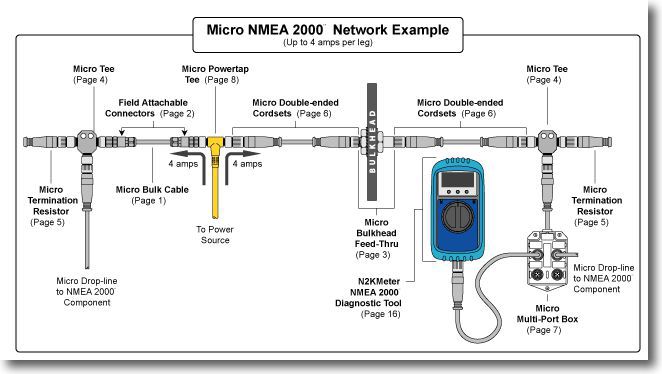

- #How to builda nmea 2000 network how to#
- #How to builda nmea 2000 network install#
- #How to builda nmea 2000 network serial#
It looks like pin 2 is used during reboot and also during programming. But I noticed problems with the NMEA2000 bus during reboot/programming of the ESP32. The standard configuration of the NMEA2000 library would block the Serial2 connection used for AIS. It works well with the ESP32.įor the Gateway, I use the pins GPIO4 for CAN RX and GPIO5 for CAN TX.
#How to builda nmea 2000 network install#
The code is based on the NMEA 2000 / NMEA0183 libraries from Timo Lappalainen ( ).ĭownload and install the libraries from GitHub link above: JSON interface on port 90 to request NMEA2000 data via JSON request (see M5Stack Display repository for example on usage).Showing fridge temperature in web browser (nice JavaScript gauge).Acknowledgement of alarm with a button.Checking voltage and temperature levels against predefined values and generating an alarm with a piezo alarm buzzer.True parallel processing: Reading OneWire sensor as isolated task on second core of ESP32 (sensor reading is blocking for about 750 ms).Fridge temperature with a Dallas DS18B20 OneWire sensor (easily extendable with more sensors).

#How to builda nmea 2000 network serial#
Forwarding serial NMEA0183 AIS information (on RX2) as UDP broadcast stream (for Navionics on tablets, but also for OpenCPN).This allows use of OpenCPN WindHistory Dashbord instument. Calculating TWS/TWD from apparent wind information and heading/COG).Forwarding navigation information from NMEA2000 to NMEA0183 as TCP stream (including log, water temp, and rudder information).Alternatively it can also connect as client to a WLAN network (set WLAN_CLIENT to 1 to enable).Providing a WiFi Access Point for other systems like tablets or computer (e.g.The Gateway supports the following functions: Pin layout for other ESP32 devices might differ. The ESP32 in this project is an ESP32 NODE MCU from AzDelivery.
#How to builda nmea 2000 network how to#
You can download the installation guide from HERE which also serves as a handy NMEA 2000 reference.This repository shows how to build a NMEA2000 WiFi Gateway with AIS multiplexing and voltage/temperature alarms. The connection system will work with all leading brands and can be expanded using standard components as required.

It’s suitable for DIY installers as well as boat builders who want an easy and value priced solution for integrating and installing modern boat electronics. This allows for a really neat and compact installation – ideal for behind the helm. The backbone is formed from a unique 6 way extension block with ports at each end that accommodate the terminators. It uses the high quality, nickel plated metal style connectors rather than the cheaper plastic type which can prove unreliable. Its also easily expandable for more devices. Most display manufacturers don’t include cabling for a network so you’ll need to build a simple network even for just 1 extra device – don’t be tempted to just plug the nmea 2000 connections together – that definately will NOT work!ĭigital Yacht have now introduced a NMEA 2000 cabling starter kit which allows for up to 3 devices to interconnect – say AIS, plotter and autopilot and comes complete with terminators and a power cable. Its sometimes called a CanBusĪ Digital Yacht AIS is often the first item to be added to a system which normally starts with a plotter or multi function plotter/radar display (MFD). Waterproof connectors are used throughout for maximum reliability and it makes for an easy plug ‘n play installation. It uses a simple backbone (sometimes called “trunk”) structure with requires terminators at the ends of the cabling and then each device can be spurred off using a drop cable. NMEA 2000 has now become the de-facto standard throughout the marine electronics industry for interconnection of devices.


 0 kommentar(er)
0 kommentar(er)
